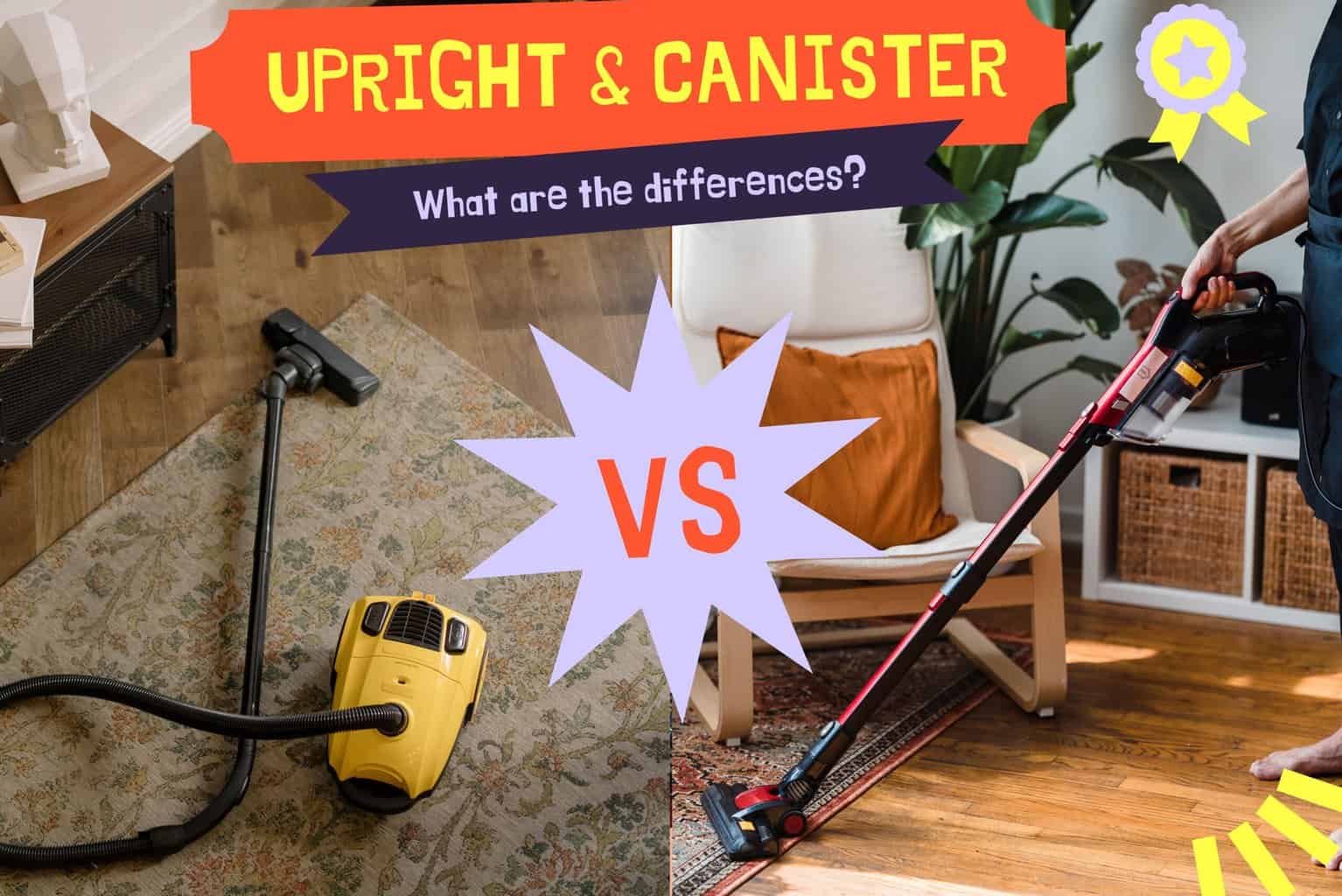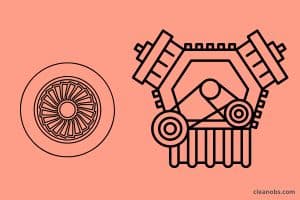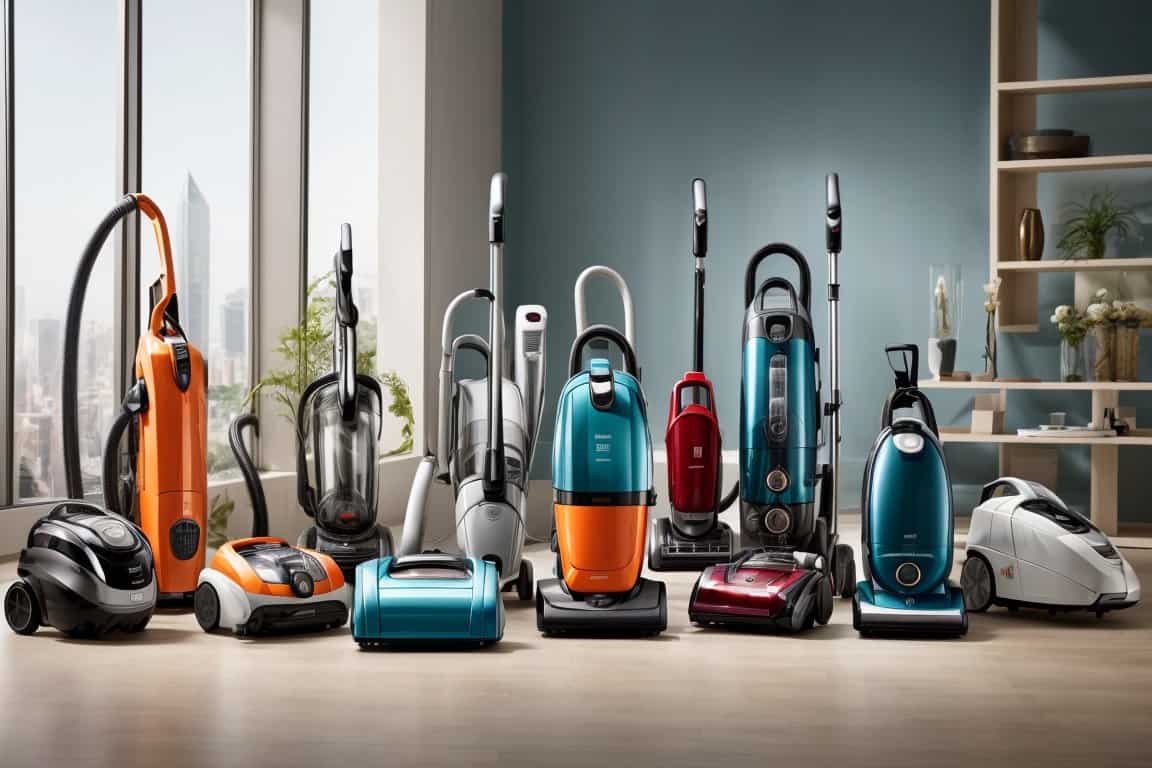
Canister vacuum cleaners and upright vacuum cleaners are two popular options for cleaning homes, but they have distinct differences. Understanding these differences can help you choose the right vacuum cleaner for your needs. In this article, we will explore the key features and benefits of both canister and upright vacuums to help you make an informed decision.
Key Takeaways:
- Canister vacuums offer flexibility and reach, making them ideal for above-the-floor cleaning and hard-to-reach areas.
- Upright vacuums provide all-in-one convenience and efficient carpet cleaning performance.
- Consider factors such as maneuverability, storage space, power, noise levels, functionality, and filtration systems when choosing between canister and upright vacuums.
- Understanding the design philosophy and functionality of each type of vacuum will help you make an informed decision.
- Both canister and upright vacuums offer powerful suction capabilities, but canister vacuums are known for their deep cleaning abilities.
Defining the Contenders: Canister vs Upright Vacuums
In this section, we will define canister and upright vacuums and highlight their main features.
Upright Vacuum Cleaners – An All-in-One Solution
Upright vacuum cleaners are designed as all-in-one solutions, with the motor, dirt container, and powerhead all attached in a single unit. They are popular for carpet cleaning and are usually easier to store.
Canister Vacuum Cleaners – Flexibility and Reach
Canister vacuum cleaners have a separate canister body and powerhead connected by hoses. This design provides greater flexibility and reach, making them ideal for hard-to-reach areas and above-the-floor cleaning tasks.
Design Philosophy: Purpose-Built for Specific Tasks
The canister and upright vacuums’ design philosophy focuses on meeting specific cleaning tasks. Canister vacuums are purpose-built to provide flexibility and reach, with attachments and features that allow for thorough cleaning of above-the-floor surfaces. On the other hand, Upright vacuums are designed for all-in-one convenience and efficiency, focusing on carpet cleaning. Understanding the design philosophy behind each type of vacuum can help you choose the right one for your specific cleaning needs.
Maneuverability and Handling in Vacuum Cleaners
When choosing a vacuum cleaner, maneuverability and handling are key factors to consider. Canister vacuums and upright vacuums offer different levels of mobility and ease of use.
The Mobility of Canister Vacuums
Canister vacuums are known for their excellent maneuverability, making them a popular choice for households with multiple surfaces to clean. Their wheeled canister body and lightweight design allow for easy movement around furniture and tight spaces. With the flexibility of a long hose and attachments, canister vacuums can effortlessly reach under furniture, clean stairs, and tackle above-the-floor cleaning tasks. The mobility provided by canister vacuums ensures thorough cleaning in hard-to-reach areas, leaving your home spotless.
Handling Upright Vacuums with Ease
Upright vacuums are designed for convenient handling, particularly in large spaces. Their self-propelling brush rolls and ergonomic handles make them easy to maneuver across various floor surfaces. The all-in-one design of upright vacuums simplifies the cleaning process, allowing you to effortlessly switch between carpeted areas and hard floors. Upright vacuums are especially convenient for individuals who have difficulty bending down or require a more upright stance while cleaning. With their ergonomic features, upright vacuums provide a comfortable grip and smooth glide, making cleaning a breeze.
Storage and Space Considerations

When choosing a vacuum cleaner, storage and space considerations are crucial, especially for those with limited storage space. You want a vacuum cleaner that not only fits in your home but also doesn’t take up too much valuable space.
Upright vacuums are generally more compact and easier to store, making them an excellent option for small living spaces. Their all-in-one design allows for convenient storage in closets or small corners. You can easily tuck them away when they’re not in use.
On the other hand, canister vacuums have separate components, including the wheeled canister body and hoses, which may require more space for storage. It would help if you considered whether you have enough room to accommodate the larger size of a canister vacuum.
It’s important to assess the available storage space in your home and determine which type of vacuum cleaner is more suitable for your needs. If space is limited, an upright vacuum might be the better choice. But if you have enough storage room, a canister vacuum can still be viable due to its powerful suction and flexibility.
The Battle for Power: Suction and Motor Efficiency
Power and suction are critical factors for effective vacuum cleaning. Canister vacuums and upright vacuums each offer unique advantages in terms of power, suction, and motor efficiency.
Suction Capabilities of Canister Vacuums

Canister vacuums are well-known for their powerful suction capabilities, which can be attributed to their design and larger motors. This strong suction enables canister vacuums to effectively deep clean carpets and effectively pick up dirt and debris from various surfaces. The combination of the canister design and a high-powered motor allows for thorough and efficient cleaning, making canister vacuums a popular choice for many households.
Upright Vacuums: When Power Meets Convenience
Upright vacuums also offer strong suction, but they prioritize convenience and efficiency with their all-in-one design. The motor, dirt container, and powerhead are all integrated into a single unit, providing a compact and easy-to-use vacuum. Upright vacuums are designed with motor efficiency in mind, offering powerful performance while being user-friendly and convenient to maneuver.
Understanding the power, suction, and motor efficiency of both canister and upright vacuums is essential in choosing the right vacuum cleaner for your cleaning needs. Canister vacuums excel in deep cleaning and versatility, while upright vacuums provide convenience and efficiency. Consider your cleaning requirements and priorities to make an informed decision on which type of vacuum cleaner will best suit your home.
Differences in Noise Levels: Quiet Operation vs Powerful Effect
The noise levels of vacuum cleaners can vary significantly between canister and upright models. Understanding the noise levels is important when choosing a vacuum cleaner that suits your needs and environment.

Acoustic Design of Canister Vacuums
Canister vacuums are known for their quiet operation, making them ideal for environments where noise reduction is important. Their acoustic design and separate components help minimize noise levels, ensuring a peaceful cleaning experience. This makes canister vacuums a great choice for apartments or spaces with thin walls, as they won’t disturb you or your neighbors.
Upright Vacuums: Sound and Fury Signifying Power
Upright vacuums, on the other hand, may produce more noise during operation compared to canister vacuums. However, their powerful cleaning performance should not be overlooked. Upright vacuums are designed to tackle deep-seated dirt and allergens in carpets, delivering a thorough cleaning experience. The sound produced by upright vacuums signifies their robust suction power and effectiveness in removing debris and allergens from your carpets.
Comparing Functionality: Above-the-Floor Cleaning
When it comes to choosing between canister and upright vacuums, functionality is an important consideration. Canister vacuums are renowned for their exceptional above-the-floor cleaning capabilities, thanks to their flexible hoses and attachments. They allow you to effortlessly clean upholstery, curtains, and other surfaces that may not be easily accessible with an upright vacuum.
However, it’s worth noting that many upright vacuums also offer attachments and features that enable above-the-floor cleaning. This makes them versatile options for tackling various cleaning tasks, including reaching high shelves or vacuuming cobwebs in corners. By understanding the functionality of both canister and upright vacuums, you can make an informed decision and choose the vacuum cleaner that best suits your specific cleaning needs.
Filtering Out the Differences: Filtration Systems and Dust Disposal
Filtration systems and dust disposal methods can vary between canister and upright vacuums. Both types of vacuums commonly feature HEPA filtration, which effectively traps allergens and particles, promoting cleaner air quality in your home. However, there are key differences in how these filtration systems function and how dust is disposed of.
HEPA Filtration and Allergen Trapping
HEPA filtration is a vital component in modern vacuum cleaners, as it helps capture microscopic particles and allergens to keep your home cleaner and healthier. Both canister and upright vacuums often come equipped with HEPA filters, but the effectiveness may vary based on the specific brand and model of the vacuum. These filters work by forcing the air through a fine mesh, effectively trapping the particles before they are released back into the air.

Bagged vs Bagless Vacuums: The Cleanup Process
When it comes to dust disposal, canister and upright vacuums offer two different options: bagged and bagless. Canister vacuums typically come with bagged options, where the collected dust and debris are deposited into disposable bags. Bagged vacuums can be more hygienic, as the bags can be sealed and thrown away, minimizing the chances of dust escaping during the disposal process.
On the other hand, upright vacuums often come with bagless options, where the dust and debris are collected in a dust container that can be emptied and reused. Bagless vacuums offer the convenience of not needing to buy replacement bags, but the dust disposal process may expose you to some level of dust and allergens if not done properly.
| Filtration Systems | Dust Disposal |
|---|---|
| Canister Vacuums | Bagged – Requires regular replacement and offers hygienic dust disposal. |
| Upright Vacuums | Bagless – Allows for easy emptying of the dust container, but requires proper handling to minimize dust exposure. |
Conclusion
In conclusion, when comparing canister and upright vacuums, it’s important to consider their unique features and benefits that cater to different cleaning needs.
Canister vacuums excel in flexibility, reach, and powerful suction, making them the ideal choice for above-the-floor cleaning and those hard-to-reach areas in your home. With their separate canister body and powerhead connected by hoses, they provide the maneuverability and versatility needed for thorough cleaning.
On the other hand, upright vacuums offer all-in-one convenience and efficient carpet cleaning performance. These vacuums, with the motor, dirt container, and powerhead all attached in a single unit, are designed to provide a seamless cleaning experience for larger spaces and focus on effectively cleaning carpets.
When deciding between canister and upright vacuums, it’s crucial to consider factors such as maneuverability, storage space, power, noise levels, functionality, and filtration systems. By evaluating these aspects, you can make an informed decision that aligns with your specific cleaning needs and preferences.
Source Links
- https://hoover.asia/en/air-stretch











